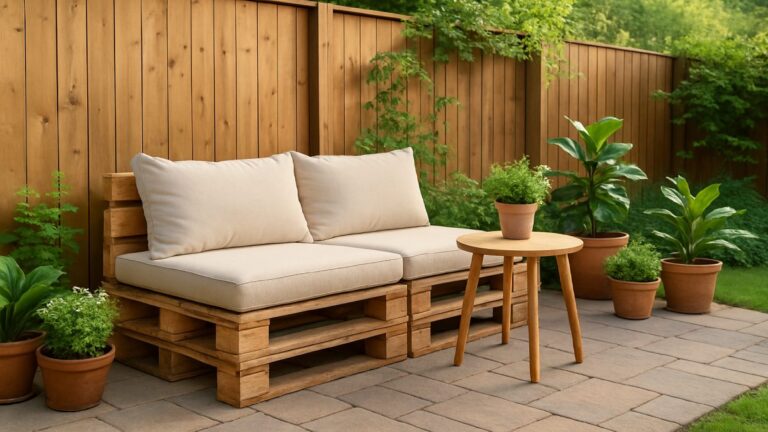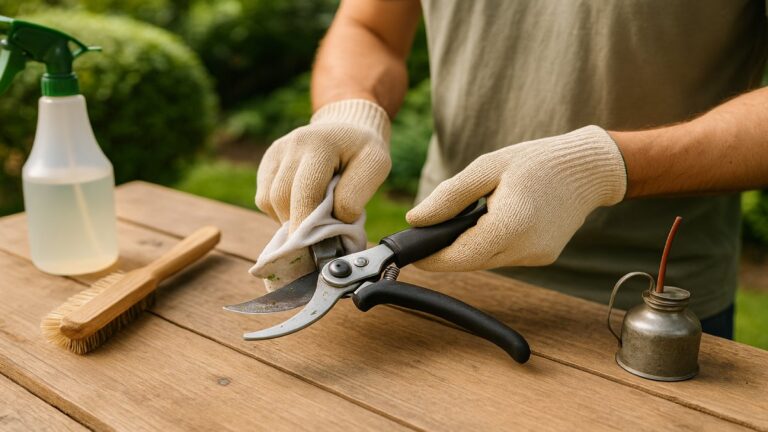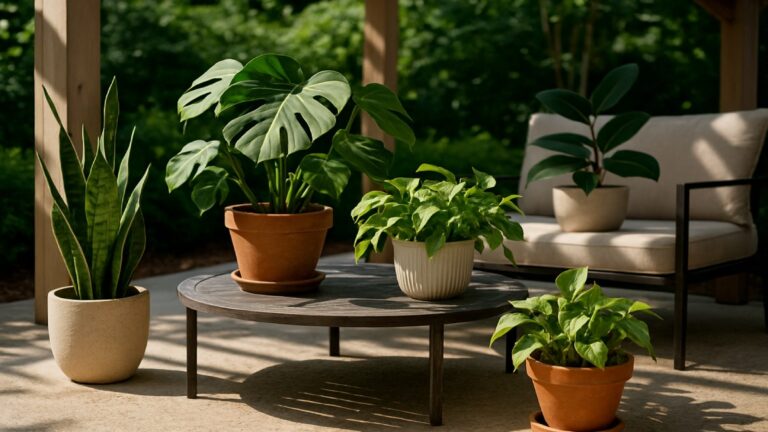Best Outdoor Lighting Ideas for Warm Patio Ambience at Night
Your patio can feel like a cozy outdoor lounge when the lighting is layered, warm, and thoughtfully placed. Instead of blasting the space with one bright fixture, blend subtle glows and focused accents so the eye moves comfortably across pathways, seating, greenery, and architectural details. This guide walks you through everything—from color temperature and fixture choices to smart controls and safe installation—so you can design evening ambience that looks intentional and feels relaxing.
The key is to plan the experience first: where you’ll sit and gather, how you’ll move from house to yard, and what you want to highlight after sunset. Once you map the “moments,” you can match each zone with the right beam width, brightness, and tone. Use the playbook below to build that soft, golden patio atmosphere without glare or harsh hotspots.
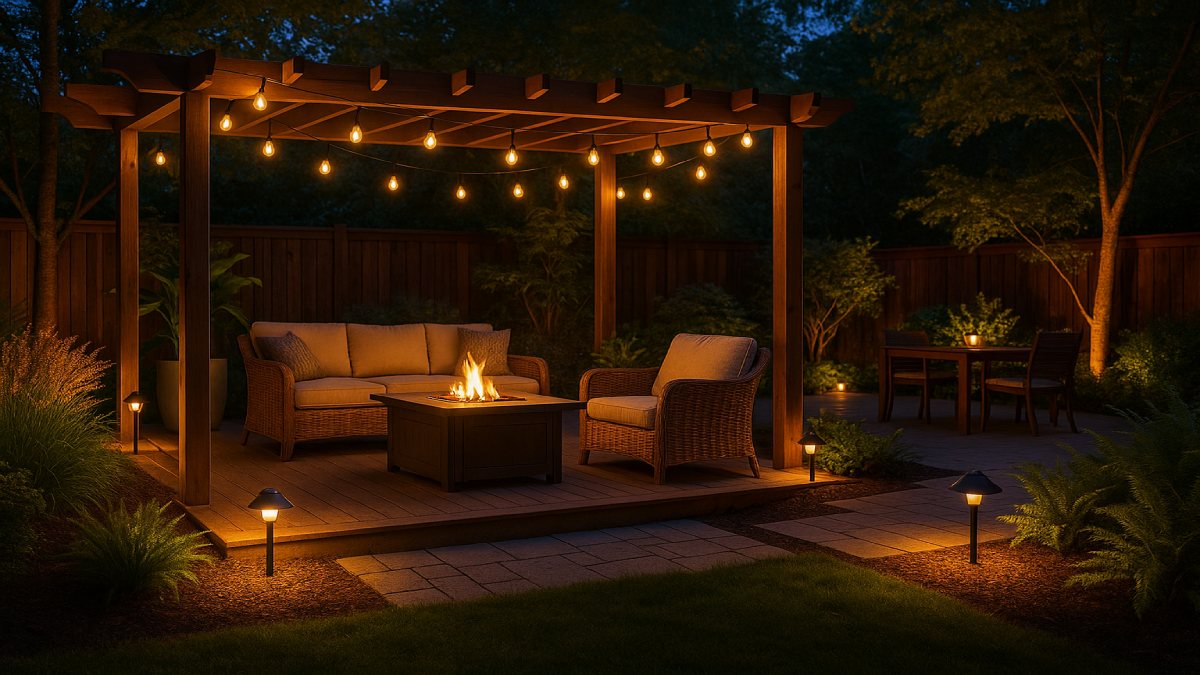
Design the Ambience First: A Quick Game Plan
Start by sketching a simple overhead view of your patio and immediate yard. Mark where people gather (sofa set, dining table), how they travel (doors, steps, paths), and what deserves attention (trees, water feature, textured wall). Next, set lighting goals for each area: soft background glow for conversation, sparkle for festive feel, and subtle highlights for depth. Keep brightness modest—enough to see faces and footing while preserving night’s calm.
Three Layers That Make Any Patio Work
- Ambient base: A low, even wash so the space feels usable and calm.
- Task accents: Focused light where you read, grill, or set drinks.
- Decor highlights: Sparkle and depth on plants, art, stone, or water.
Get the Color Right: Warmth Beats Brightness
For evenings, prioritize warmth over sheer lumens. Color temperature in the 2200–2700K range produces an amber glow that flatters skin tones and materials like wood, stone, and rattan. If you want a slightly crisper mood for dining or board games, choose a dimmable 2700–3000K lamp and keep a lower setting for most of the night.
Quick Color-Temperature Guide
- 2200–2400K: Candlelike amber; best for string lights, lanterns, and cozy lounge zones.
- 2700K: Warm white; versatile for sconces, pendants, and path lights.
- 3000K: Soft white; good for task areas like cooking or games if dimmable.
Choose the Right Fixtures for Each Job
Each fixture type solves a different problem. Combine several, but keep each one modest so the whole scene feels balanced.
String Lights & Overhead Glow
String lights add sparkle and outline overhead space without heavy brightness. Look for shatter-resistant “café” or “Edison” style bulbs at 2200–2700K with weatherproof ratings (UL wet or damp listed). Keep lines taut and symmetrical to avoid sag shadows.
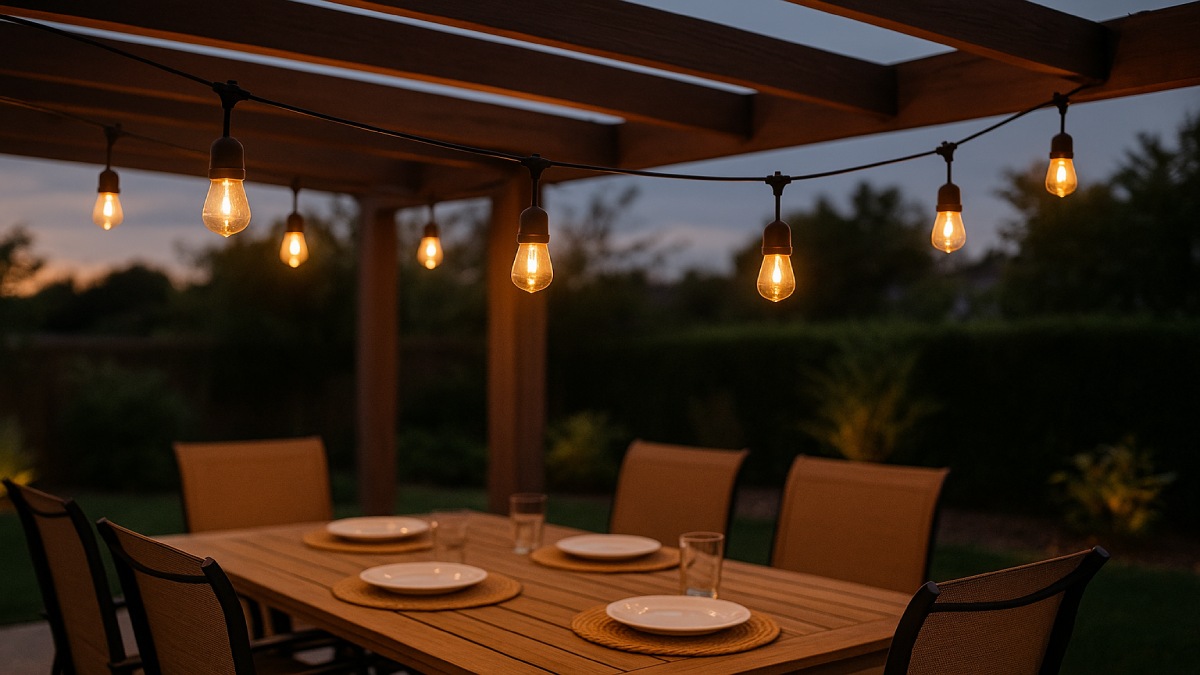
Wall Sconces & Lanterns
Mount sconces near doors and transitions. Choose shielded or frosted lenses to soften direct LED points. Dark-sky–friendly designs keep light down and out rather than up into the sky or straight into eyes.
Path & Step Lights
Small, shielded path lights placed 8–12 feet apart guide guests without creating runway vibes. Step lights should be louvered or diffused and set at low output to prevent tripping hazards and glare.
Uplights & Downlights
Uplights make trees and textured walls feel dramatic; use narrow beams (10–25°) for tall trunks and wider washes (35–60°) for foliage. From overhead structures, downlights (“moonlighting”) cast a gentle, natural-looking glow with leafy shadow play—aim fixtures to avoid shining into eyes.
Portable Lamps & Candles
Rechargeable table lamps and hurricane lanterns add intimacy right at the seating level. Choose low-glare diffusers and keep color temperature consistent with the rest of your scheme.
Brightness, Beam, and Glare: The Comfort Triad
Brightness is more than wattage—look at lumens, diffusion, and aiming. You want enough light for safe footing and easy conversation, but not so much that the patio reads as a stage.
Practical Targets
- Gathering zones: 50–150 lumens per fixture, dimmable.
- Paths & steps: 20–80 lumens per fixture with shielding.
- Feature uplights: 150–400 lumens depending on height and distance.
Reduce Glare
- Pick shielded fixtures or frosted lenses.
- Mount at eye-sparing angles; aim away from seating sightlines.
- Use dimmers or multi-output fixtures to scale down as the night deepens.
Low-Voltage, Solar, or Smart Portable? Power Options Compared
There’s no single “best” power approach—mixing options often works best. Low-voltage (12V) systems are reliable, dimmable, and scalable; solar is flexible and ultra-simple; portable rechargeable lamps fill gaps and add tabletop glow.
Low-Voltage (12V) Systems
- Pros: Consistent output, broad fixture choice, dimmable with the right transformer/driver.
- Cons: Requires transformer, cable runs, and basic layout planning.
Solar Fixtures
- Pros: No wiring, fast setup, easy to move seasonally.
- Cons: Performance varies by climate and season; look for high-quality panels and batteries.
Rechargeable & Plug-In Lamps
- Pros: Perfect for tabletops; place exactly where needed.
- Cons: Battery management and charging logistics; plug-in lamps need weather-safe outlets.
Smart Controls & Dimmers: Set It and Forget It
Smart plugs, dimmers, and outdoor-rated hubs help your lighting rise and fade with sunset, trigger scenes from your phone, and coordinate with other home automations. Start simple with sunset-to-sunrise schedules, then layer timed dimming for late evening wind-down.
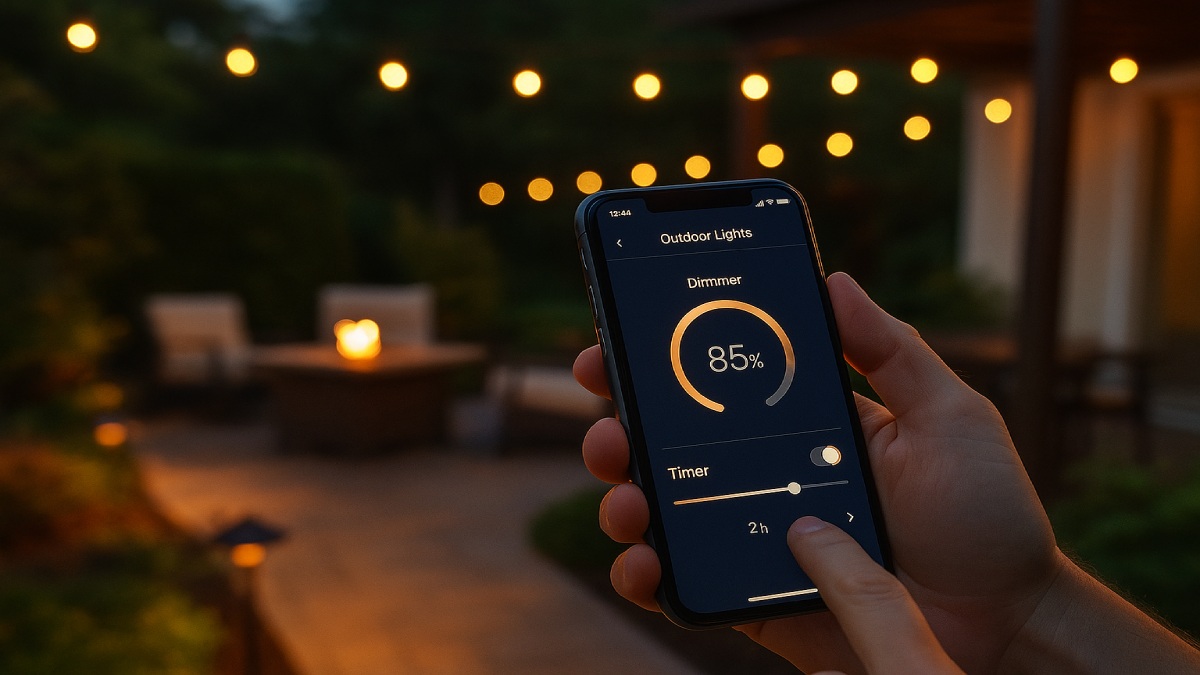
Scene Ideas That Always Work
- Welcome: Entry sconces 70%, path lights 60%, string lights 50%.
- Dinner: Table pendant/lanterns 60%, background glow 40%.
- Lounge: String lights 35%, uplights 30%, step lights 25%.
- Late: Safety only—paths and steps around 20%.
Layout Basics: Height, Spacing, and Aiming
Good spacing prevents hot spots and dark voids. Think in terms of coverage and overlap rather than a grid of identical fixtures.
Rules of Thumb
- String lights: 12–24 inches between bulbs; keep lines taut.
- Path lights: Stagger 8–12 feet apart; avoid straight “runway” symmetry.
- Step lights: 3–6 feet spacing depending on riser width and brightness.
- Uplights: Place 1–3 feet from trunks or walls; adjust beam to the subject.
Safety & Outdoor Ratings
Outdoor fixtures and accessories must carry appropriate damp/wet location ratings. Use weatherproof junction boxes, in-use outlet covers, and outdoor-rated extension cords only when necessary (and only temporarily). Keep cable runs tidy and concealed to avoid tripping.
What to Check on Labels
- Wet vs. damp: Fixtures directly exposed to rain need “wet” rating.
- IP rating: Higher is better (e.g., IP65) where sprinklers or heavy rain are common.
- Temperature range: Ensure LEDs are rated for your seasonal extremes.
Step-by-Step: Install a Small Low-Voltage Zone
- Plan the run: Mark transformer location near a GFCI outlet; sketch fixture points.
- Lay cable: Run 12–14 gauge landscape wire along edges; leave slack for adjustments.
- Connect fixtures: Use gel-filled or compression connectors; follow polarity.
- Set transformer: Match wattage to total load with 20–30% headroom; add a timer or smart plug.
- Fine-tune aiming: Wait until dusk to set angles and trim brightness.
Maintenance Keeps the Magic Going
Once per season, wipe lenses, straighten string lines, clear leaves from path lights, and check cable connections. Replace failed solar batteries as needed and keep panels clean for maximum charge. Revisit dimmer scenes as trees grow and furniture moves.
Budget Playbook: Good, Better, Best
Good (Fast Glow-Up)
- One or two strands of warm string lights.
- Solar path markers at key transitions.
- Rechargeable table lamps for dining and games.
Better (Layered & Reliable)
- Low-voltage path and step lights with a small transformer.
- Two wall sconces near doors with warm, frosted lamps.
- Smart dimmer or outdoor smart plug for scenes.
Best (Fully Orchestrated)
- Mixed low-voltage system: path, step, uplights, downlights.
- Architectural wash for a textured wall or water feature.
- Smart-home integration with sunrise/sunset automation.
Common Mistakes to Avoid
- Too bright: High output ruins ambience and attracts bugs.
- Unshielded glare: Bare LED points are harsh; diffuse and aim carefully.
- One-note lighting: Only string lights or only path lights creates a flat look; mix layers.
- Random color temps: Keep within a tight range (2200–2700K) for cohesion.
- Ignoring safety: Wrong ratings or sloppy wiring lead to failures and hazards.
Patio Scenarios You Can Copy
Cozy Conversation Nook
String lights at a low dim level, two portable table lamps, and gentle downlighting from a pergola rafter. A single uplight for the feature plant adds dimension without overpowering the eye.
Al Fresco Dining
Soft pendant or lantern above the table at 2700K, path lights guiding to the kitchen door, and a wall sconce at the entry. Dim to 50–60% during meals to keep faces flattering and reflections controlled.
Entertaining Zone
Layered string lights for sparkle, step lights for safe movement, and a few uplights grazing a stone wall or specimen tree. Smart scenes let you start brighter for arrival and fade to lounge mode later.

Frequently Asked Questions
How many lumens do I need for a small patio?
Think in layers rather than one target number. A dozen modest fixtures (20–150 lumens each) placed with intent usually beat one bright lamp. Prioritize dimmable control.
What’s the easiest way to start?
Begin with warm string lights and two rechargeable table lamps. If you like the vibe, add path lights, then a few feature uplights.
Are solar lights worth it?
Quality solar fixtures are great for accent and wayfinding, especially in sunny climates. For guaranteed consistency or heavy shade areas, go low-voltage wired.
How do I avoid bugs swarming the lights?
Use warmer color temperatures, avoid overly bright, unshielded beams, and keep light directed down and in—not up or across open air.
Wrap-Up: A Warm Patio That Fits Every Evening
When you blend cozy color, gentle brightness, and thoughtful placement, your patio transforms into an inviting evening retreat. Focus on three layers—ambient base, task-ready accents, and decorative highlights—then choose fixtures purposefully and control them with dimmers or smart schedules. Keep the tech simple, the beams shielded, and the color warm, and you’ll enjoy calm, flattering light that makes every night outside feel special.




